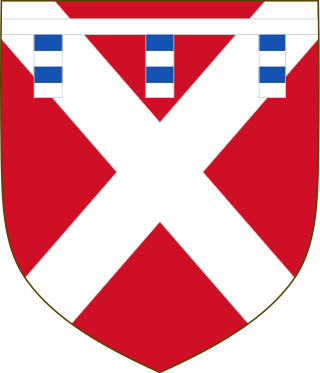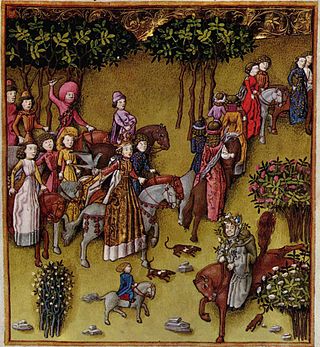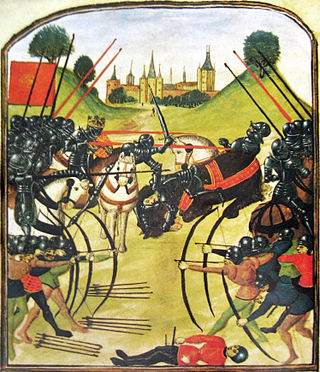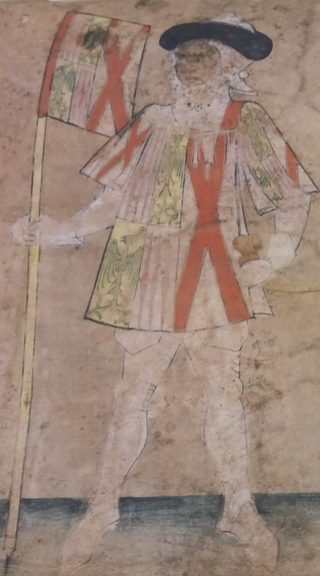
Edward IV was King of England from 4 March 1461 to 3 October 1470, then again from 11 April 1471 until his death in 1483. He was a central figure in the Wars of the Roses, a series of civil wars in England fought between the Yorkist and Lancastrian factions between 1455 and 1487.

Henry VI was King of England from 1422 to 1461 and again from 1470 to 1471, and disputed King of France from 1422 to 1453. The only child of Henry V, he succeeded to the English throne upon his father's death, at the age of nine months; and succeeded to the French throne on the death of his maternal grandfather, Charles VI, shortly afterwards.

Richard Neville, 16th Earl of Warwick, 6th Earl of Salisbury, known as Warwick the Kingmaker, was an English nobleman, administrator, landowner of the House of Neville fortune and military commander. The eldest son of Richard Neville, 5th Earl of Salisbury, he became Earl of Warwick through marriage, and was the wealthiest and most powerful English peer of his age, with political connections that went beyond the country's borders. One of the leaders in the Wars of the Roses, originally on the Yorkist side but later switching to the Lancastrian side, he was instrumental in the deposition of two kings, which led to his epithet of "Kingmaker".

Edmund Beaufort, styled 4th Duke of Somerset, 6th Earl of Somerset, 3rd Marquess of Dorset, 3rd Earl of Dorset, was an English nobleman, and a military commander during the Wars of the Roses, in which he supported the Lancastrian king Henry VI.

Humphrey Stafford, 1st Duke of Buckingham, 6th Earl of Stafford, 7th Baron Stafford, of Stafford Castle in Staffordshire, was an English nobleman and a military commander in the Hundred Years' War and the Wars of the Roses. Through his mother he had royal descent from King Edward III, his great-grandfather, and from his father, he inherited, at an early age, the earldom of Stafford. By his marriage to a daughter of Ralph, Earl of Westmorland, Humphrey was related to the powerful Neville family and to many of the leading aristocratic houses of the time. He joined the English campaign in France with King Henry V in 1420 and following Henry V's death two years later he became a councillor for the new king, the nine-month-old Henry VI. Stafford acted as a peacemaker during the partisan, factional politics of the 1430s, when Humphrey, Duke of Gloucester, vied with Cardinal Beaufort for political supremacy. Stafford also took part in the eventual arrest of Gloucester in 1447.

Richard Neville, 5th Earl of Salisbury KG PC was an English nobleman and magnate based in northern England who became a key supporter of the House of York during the early years of the Wars of the Roses. He was the father of Richard Neville, 16th Earl of Warwick, the "Kingmaker".
John Neville, 1st Marquess of Montagu was a major magnate of fifteenth-century England. He was a younger son of Richard Neville, 5th Earl of Salisbury, and the younger brother of Richard Neville, Earl of Warwick, the "Kingmaker".

A retinue is a body of persons "retained" in the service of a noble, royal personage, or dignitary; a suite of retainers.

John Mowbray, 3rd Duke of Norfolk,, Earl Marshal was a fifteenth-century English magnate who, despite having a relatively short political career, played a significant role in the early years of the Wars of the Roses. Mowbray was born in 1415, the only son and heir of John de Mowbray, 2nd Duke of Norfolk, and Katherine Neville. He inherited his titles upon his father's death in 1432. As a minor he became a ward of King Henry VI and was placed under the protection of Humphrey, Duke of Gloucester, alongside whom Mowbray would later campaign in France. He seems to have had an unruly and rebellious youth. Although the details of his misconduct are unknown, they were severe enough for the King to place strictures upon him and separate him from his followers. Mowbray's early career was spent in the military, where he held the wartime office of Earl Marshal. Later he led the defence of England's possessions in Normandy during the Hundred Years' War. He fought in Calais in 1436, and during 1437–38 served as Warden of the Eastern March on the Anglo-Scottish border, before returning to Calais.

John de la Pole, 2nd Duke of Suffolk, KG, was a major magnate in 15th-century England. He was the son of William de la Pole, 1st Duke of Suffolk, and Alice Chaucer, the daughter of Thomas Chaucer. His youth was blighted, in 1450, by the political fall and subsequent murder of his father, who had been a favourite of king Henry VI but was increasingly distrusted by the rest of the nobility. Although the first duke of Suffolk had made himself rich through trade and – particularly – royal grants, this source of income dried up on his death, so John de la Pole was among the poorest of English dukes on his accession to the title in 1463. This was a circumstance which John felt acutely; on more than one occasion, he refused to come to London due to his impoverishment being such that he could not afford the costs of maintaining a retinue.
Michael A. Hicks is an English historian, specialising in the history of late medieval England, in particular the Wars of the Roses, the nature of late medieval society, and the kings and nobility of the period.

William Bonville, 1st Baron Bonville, was an English nobleman and an important, powerful landowner in south-west England during the Late Middle Ages. Bonville's father died before Bonville reached adulthood. As a result, he grew up in the household of his grandfather and namesake, who was a prominent member of the Devon gentry. Both Bonville's father and grandfather had been successful in politics and land acquisition, and when Bonville came of age, he gained control of a large estate. He augmented this further by a series of lawsuits against his stepfather, Richard Stucley. Bonville undertook royal service, which then meant fighting in France in the later years of the Hundred Years' War. In 1415, he joined the English invasion of France in the retinue of Thomas, Duke of Clarence, Henry V's brother, and fought in the Agincourt campaign. Throughout his life, Bonville was despatched on further operations in France, but increasingly events in the south-west of England took up more of his time and energy, as he became involved in a feud with his powerful neighbour Thomas Courtenay, Earl of Devon.

The Dunstable Swan Jewel is a gold and enamel brooch in the form of a swan made in England or France in about 1400 and now in the British Museum, where it is on display in Room 40. The jewel was excavated in 1965 on the site of Dunstable Friary in Bedfordshire, and is presumed to have been intended as a livery badge given by an important figure to his supporters; the most likely candidate was probably the future Henry V of England, who was Prince of Wales from 1399.

The Readeption was the restoration of Henry VI of England to the throne of England in 1470. Edward, Duke of York, had taken the throne as Edward IV in 1461. Henry had fled with some Lancastrian supporters and spent much of the next few years in hiding in Northern England or in Scotland, where there was still some Lancastrian support. Henry was captured in 1465 and was held as a prisoner in the Tower of London. Following dissent with his former key supporter, Richard Neville, 16th Earl of Warwick, Edward was forced to flee in 1470. Henry was then restored to the throne, although he was deposed again the following year.

The Wars of the Roses (1455–1487), known at the time and for more than a century after as the Civil Wars, was a series of civil wars fought over control of the English throne in the mid-to-late fifteenth century. These wars were fought between supporters of two rival cadet branches of the royal House of Plantagenet: Lancaster and York. The wars extinguished the last male line of the House of Lancaster in 1471, leading to the Tudor family inheriting the Lancastrian claim to the throne. Following the war and the extinction of the last male line of the House of York in 1485, a politically arranged marriage united the Houses of Lancaster and York, creating a new royal dynasty which inherited the Yorkist claim as well, thereby resolving the conflict.

Thomas de la More was a fifteenth-century sheriff of Cumberland. Little is known of his early years, but he was a royal official in Cumberland and Westmorland for all his adult life, serving as member of parliament, escheator and justice of the peace on multiple occasions. Although never wealthy, de la More was a man of social and political significance in the area and regularly acted on behalf of his fellow gentry. He entered the circle of Richard Neville, Earl of Salisbury at some point in the 1440s. He was frequently appointed sheriff of Cumberland. Because of this, and his close connection to the Percy family's rivals, the Nevilles, he eventually became involved in the struggle for local supremacy in the 1450s that broke out between the two families. Between 1453 and 1454, his men were beaten and threatened by Thomas Percy, Lord Egremont. In 1455, de la More petitioned the King, accusing Egremont of rampaging through Cumberland, assaulting de la More and threatening his life. He claimed this prevented him, as sheriff, from collecting money for the Treasury, although the damage to the land from Scottish incursions was more to blame. De la More played no active part in the Wars of the Roses, which broke out the same year.
Sir John Conyers, one of twenty-five children of Christopher Conyers, was a pre-eminent member of the gentry of Yorkshire, northern England, during the fifteenth century Wars of the Roses.

Sir Thomas Neville was the second son of Richard Neville, 5th Earl of Salisbury, a major nobleman and magnate in the north of England during the fifteenth-century Wars of the Roses. Sir Thomas was a younger brother to the more famous Richard Neville, Earl of Warwick, the 'Kingmaker'. Thomas worked closely with them both in administering the region for the Crown and became a leading player in the turbulent regional politics of northern England in the early 1450s, especially in the Neville family's growing local rivalry with the House of Percy. In the armed feud between both houses, which broke out in 1453 and lasted two years, Thomas and his brother John launched a series of raids, ambushes and skirmishes across Yorkshire against the Percy family. Historians describe the feud as setting the stage for the Wars of the Roses, the dynastic struggle between the houses of Lancaster and York for the English throne, and Thomas played a large role in the Neville family's alliance with his uncle, Richard, Duke of York.

In post-classical history, an affinity was a collective name for the group (retinue) of (usually) men whom a lord gathered around himself in his service; it has been described by one modern historian as "the servants, retainers, and other followers of a lord", and as "part of the normal fabric of society". It is considered a fundamental aspect of bastard feudalism, and acted as a means of tying magnates to the lower nobility, just as feudalism had done in a different way.
Richard Neville, 5th Earl of Salisbury was a fifteenth-century English northern magnate. He was the eldest son by the second wife of Ralph Neville, 1st Earl of Westmorland, from whom he inherited vast estates in Yorkshire and the North West of England. He was a loyal Lancastrian for most of his life, serving the king, Henry VI, in France, on the border with Scotland, and in many of the periodic crises of the reign. He finally joined York in his last rebellion in the late 1450s and became a Yorkist leader during the early parts of the Wars of the Roses. This led directly to his death following the Battle of Wakefield in December 1460, when he was captured and subsequently put to death in Pontefract Castle.
















